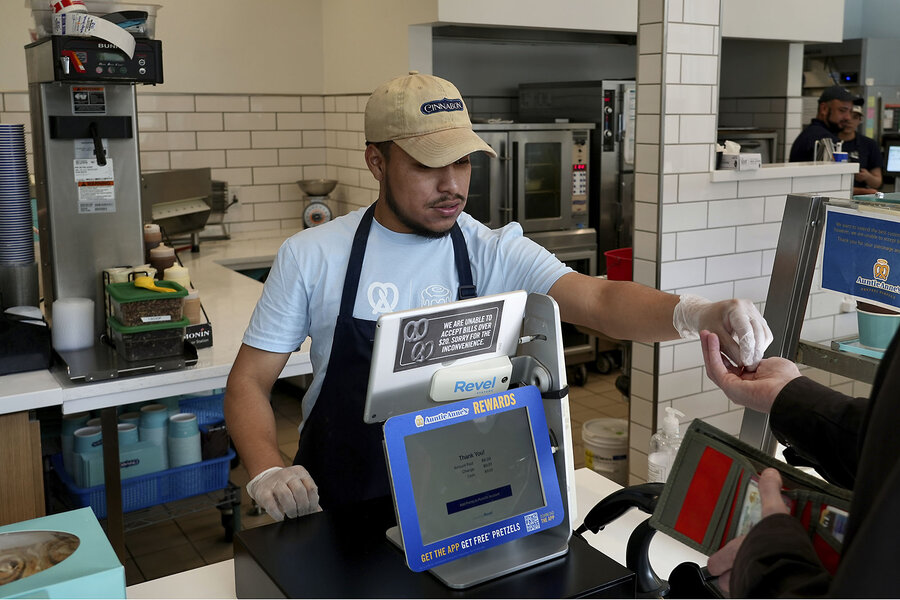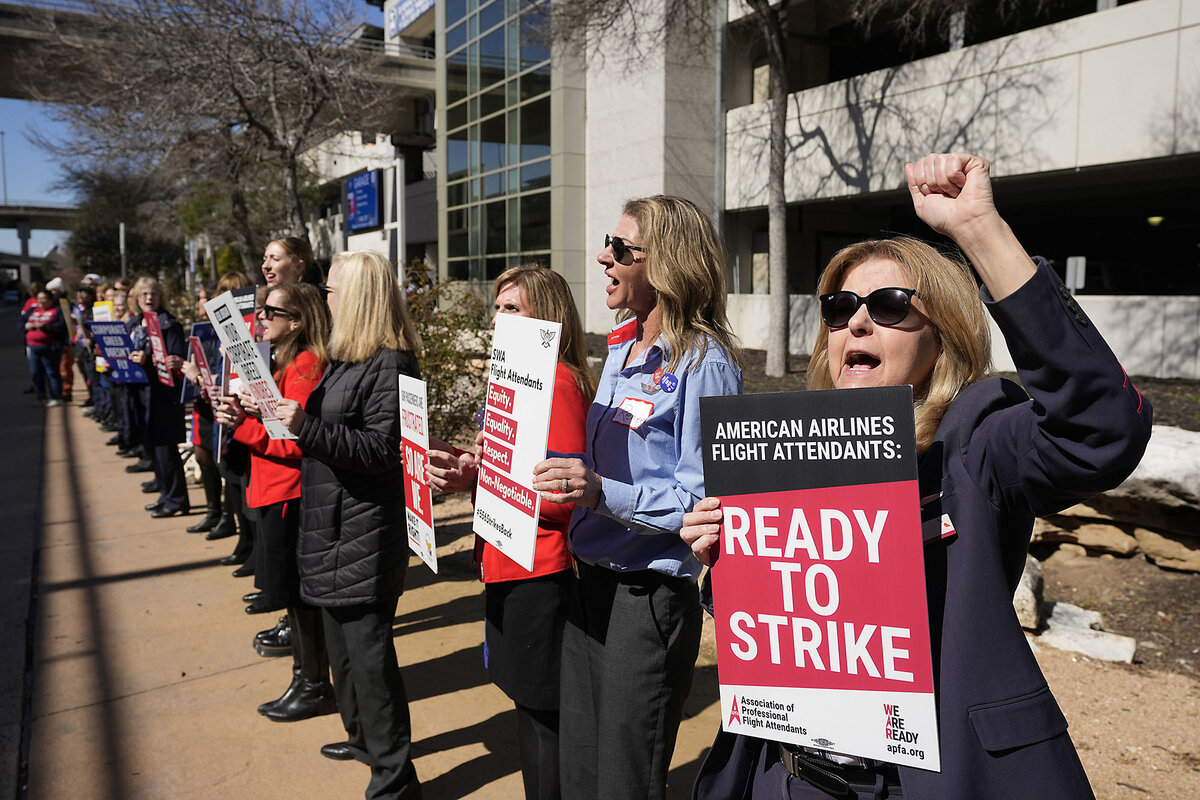Pay was starting to outpace US inflation. Can it keep up?
Loading...
Stubborn inflation is not only upsetting investors, who are hoping for interest rate cuts; it’s also threatening to undermine one of the most positive trends in the U.S. economy: the rise in workers’ real wages.
Real – or inflation-adjusted – pay took a tumble for a time during the pandemic, as prices rose far faster than Americans’ wages and salaries. But a year and a half ago, that equation flipped, and workers’ buying power began to rise again. By this past January, it looked as though their real wages were poised to resume a historic surge that started in the mid-2010s.
Now, that progress is threatened. Average real wages, which hit $11.14 an hour in January, had eased to $11.11 by March. Whether that stagnation is temporary or more lasting is anybody’s guess. But one thing is clear: If inflation doesn’t fall, it will be harder for Americans’ real pay to continue rising.
Why We Wrote This
A story focused onGains in real wages often happen during relatively rare bursts. For a while, it looked like one of those accelerations in worker buying power was underway after the pandemic. But an uptick in inflation threatens it.
“We had some good progress being made,” says Mark Hamrick, senior economic analyst at Bankrate, which tracks savings and lending rates that banks offer to consumers. “In recent months, that progress has stalled.” That means the Federal Reserve may hold off on cutting interest rates until it’s clear inflation will continue to fall.
One reason inflation isn’t falling: soaring auto-insurance rates. Last month, they jumped much higher than many analysts expected. One Connecticut resident was so shocked at the nearly 42% rise in her auto renewal quote that she’s switching insurance companies.
Unlike food and energy prices, which vary a lot from month to month, the cost of insurance and other goods and services like rent and health care makes up what’s known as core inflation. Economists keep a close eye on it. Since hitting an annualized high of 6.5% two years ago, core inflation has fallen halfway to the 2% annual inflation target that the Federal Reserve has set. While that’s impressive, it still may prove too high for Americans’ pay gains to keep up with.
In March, for example, a 0.3% monthly gain in average wages was swamped by a 0.4% rise in the core consumer price index (CPI), the Bureau of Labor Statistics reported last week. So while an average worker making $5,000 a month got a monthly bump of $15, it doesn’t cover the additional $20 that inflation added to their expenses.
Housing hurdles
A bigger reason for stubborn inflation: the rising cost of housing. Bryan Whittington left his dream job as a zookeeper for higher pay and more flexibility as a medical school coordinator at Tulane University. But a 25% rise in rent over five years has crimped his spending power. “It’s kind of disheartening,” he says. “There’s no way I can keep up with that pace with my job.”
Inflation is so persistent that some analysts suggest that the Federal Reserve may have to raise interest rates rather than lower them, as many investors are hoping for.
The post-pandemic outlook for real wages looks confusing, in part because two forces are competing for dominance: a persistent worker shortage that boosts wages, and an unexpectedly buoyant economy, which helps keep inflation high.
It’s “still to be determined whether or not we’re going to be back on that same trend we were before the pandemic,” says Chloe East, co-author of a 2023 Brookings Institution study on inflation and wages and an economics professor at the University of Colorado in Denver.
For much of the past four decades, this tug of war between wages and inflation has been a near stalemate, punctuated by short bursts of progress when Americans’ real pay went up. That happened in the mid-1980s, the late 1990s, and again around 2015, when the economy finally shook off lingering effects of the Great Recession. During the last year and a half of the Obama administration and the first three years of the Trump administration, average real wages went up by a dollar an hour – in half the time it took for the previous dollar-per-hour raise. Then the pandemic hit.
First, lockdowns pushed millions of low-wage employees out of work. When they began to trickle back to work, high inflation kicked in, reversing pay gains. Then in mid-2022, the average real wage began climbing again. Averages, however, miss important differences among Americans.
Rising costs hurt renters, help homeowners
For one, the rising cost of housing hurts renters, but it actually helps older, established homeowners, because home values go up while the real cost of mortgages goes down. In another twist, the rise in real pay that started in the mid-2010s has helped low-income workers far more than high-income ones, says Professor East of the University of Colorado.
That’s partly because low-paid workers have been in demand as restaurants, stores, and other services reopened after the pandemic. Low-paid workers have also been helped by minimum wage boosts. In January, minimum pay rose in 22 states and is expected to go up in three others later this year.
Higher pay helped lure Mitchell Redd from his native Mississippi to Atlanta, where he now works as a research analyst for the Judicial Council of Georgia. Just before he arrived in 2022, Georgia bumped up pay for all state employees and teachers by $5,000 a year. That pushed Mr. Redd’s income to $49,000 a year, far above anything he could find in Mississippi. “It’s kind of where I wanted to start my career,” he says.
Last month, Georgia passed an additional 4% raise for state employees, which the governor has been pushing to retain quality workers.
Still, rising prices cut into those pay gains.
In November, high rent forced New Yorker Eric Doce out of his apartment in Flatbush, Brooklyn, and into his grandmother’s home in Jackson Heights, Queens. A harpist by training, he works full time as an Uber Eats courier. After the city capped his hours and the company cut his pay, he figures he can clear over $30,000 a year. It is hard – with that salary – to make ends meet in one of America’s most expensive cities.
“I’ve just been here all my life,” he says. “Recently, I have seriously considered going to take a breather and move somewhere else.”









